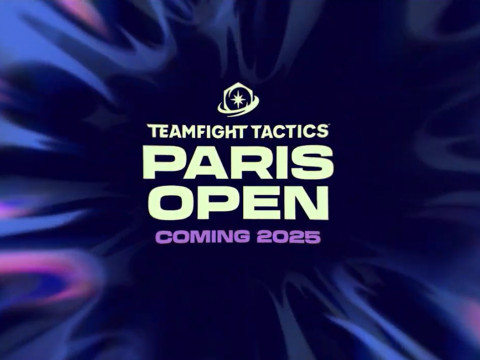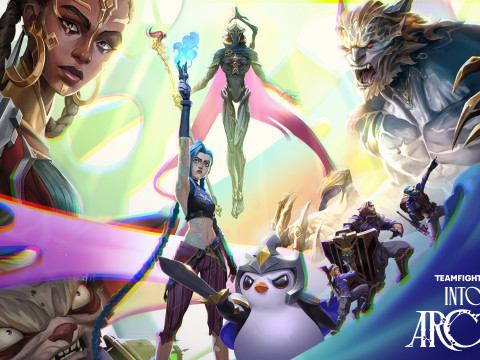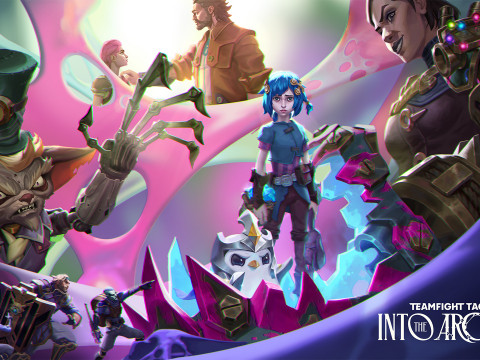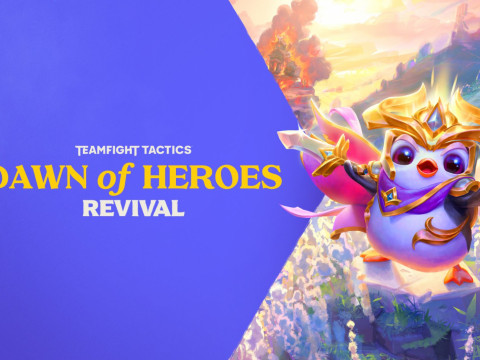
Inven Global had the chance at an exclusive peek behind the curtain at the making of Magic n’ Mayhem, the latest and most whimsical set for Teamfight Tactics (TFT). Today, we’re thrilled to have with us two key developers behind the magic: Matt Dunn, Gameplay Designer, and Dan Townsend, the Lead Game Producer.
In this interview, we dive into the challenges they faced, from conjuring up enchanting new mechanics to integrating beloved champions from other Riot Games titles. We’ll also explore the creative vision that brings the vibrant world of the Magitorium to life, ensuring it’s a spellbinding experience for both new and veteran players. And, of course, we’ll uncover the secrets of the Charms mechanic, a feature sure to add a sprinkle of fun to your gameplay.
So, sit back, grab your wands, and prepare for a journey into the heart of Magic n’ Mayhem!
What were the most significant challenges faced during the development of Magic n’ Mayhem?
Matt Dunn, Gameplay Designer: Charms, the set mechanic for Magic n' Mayhem, certainly posed a significant challenge. The basic idea sounds simple enough: put things in the shop that have cool magical effects when you buy them. However, getting the specifics of that idea right took a lot of work.
To start with, we had to determine what these were going to look like in the shop. We had to figure out how to draw players’ eyes to each Charm, how to indicate what each Charm does, what players see after they purchase a Charm, whether players should be able to see what their opponents’ Charms did after an attack, and how to showcase all of this information on both PC and mobile platforms without overwhelming players.
There were also nuances to the gameplay to figure out, like how often Charms should appear, whether players should be able to see and/or buy more than one Charm at a time, how powerful each charm should be, how many Charms we should create, and more.
Finding answers to all these questions and more was a crucial part of making Charms a reality in-game. It took a decent chunk of iteration to iron out all the answers, but those details were important for making Charms feel smooth and intuitive. We ended up with a robust collection of over 100 Charms, which will allow players to master all varieties of magic and preserve that exciting feeling of discovery after they’ve played a few games. We’re looking forward to seeing players’ reactions!
How did the team decide on the theme and design elements for Magic n’ Mayhem?
Dan Townsend, Lead Game Producer: Usually when we're deciding on a theme, we start with understanding the tone that we want to convey. This will often be based on the sets that are released before and after whatever set we're building, because we try not to have multiple consecutive sets with overlapping themes. For Magic n' Mayhem, we were preceded by Inkborn Fables which has a more serious tone than many of our sets. As the summer set, we wanted Magic n’ Mayhem to have a lighter and more playful tone. When planning our sets, we often start with a high-level genre. Magic n’ Mayhem fit within the fantasy genre, so we chose our theme and design elements accordingly. We also did a lot of play testing during the early periods of development to make sure that the set felt cohesive.
Can you give us more details on the new gameplay mechanic, Charms? How do they enhance the gameplay experience?

Matt Dunn: Charms are magical effects that you can buy. They appear in your shop just like champions do, and they each have a cost in either gold or player health. On their shop card, where you'd normally see an image of the champion, you'll instead see a description of what the Charm will do when you buy it.
There are a number of outputs Charms can have. Many will give you some sort of bonus for your next combat, like Summon Voidling, which will add a Voidling to your army for the turn. Others can give you more long-term benefits by conjuring things like item anvils or Champion Duplicators to use. There are some that present little mini-games, like Minor Gambit, which gives you gold if you win your next fight. And that's just scratching the surface: you can see Charms that let you fill your shop in specific ways, that transform your champions, or that even let you cheat death for a turn. Charms allow us to give more bite-sized rewards that might otherwise be hard to find a home for.
Due to their smaller nature, Charms create more fun, magical little moments throughout the game. This is different from mechanics like Treasure Dragon in Dragonlands (set 7), Encounters from Inkborn Fables (set 11), and even Augments when they were first announced in Gizmos and Gadgets (set 6), which tended to create a smaller number of big moments in the game. While that's great for the feel those sets were aiming for, with Magic n' Mayhem, we wanted to switch up gameplay by moving to the other side of the scale. Charms create the feel of a magical world. Mechanically, they also help alleviate the pressure of each individual decision. While skill definitely still matters when competing, you won't feel like you have to choose the correct Charm each time to succeed in the moment-to-moment gameplay, and you should even feel comfortable in the moments when you choose to not engage with the system.

What was the process of selecting which champions and traits to include in this set?
Dan Townsend: For every TFT set, we spend a lot of time considering which available Champions, skin lines, traits and set mechanics that fit into our theme, and we create lists of potential options for Origins. In the case of Magic n’ Mayhem, we already had tons of League of Legends champions and skins that interact with magic in a variety of ways.
From there, we developed example traits and wrote brief explanations about how they fit into the overall thematic. Our Art team gathered references and created concepts to build the world of the Magitorium. We went through multiple stages of feedback and iterations to really nail down that theme. We swapped out various Champions, traits and skins while the design team fit the available pieces into a trade web that made sense for TFT.
Throughout this time, we also looked for new opportunities to utilize more of our available intellectual properties and worked with our other TFT teams to showcase brand-new content. Norra from Legends of Runeterra, a new 5-cost Portal Mage, was a perfect example of this. From there, we collaborated with the gameplay team to understand what assets we had available.
We ended up with a robust roster of 60 champions including 27 traits and 3 new characters. All of these elements came together to fit into the world of the Magitorium, and hopefully our players will feel immersed in our storytelling.
How do the new champions, especially those debuting from other Riot Games titles, integrate into the existing TFT ecosystem?
Dan Townsend: All of our games are constantly delivering amazing new content, and being able to showcase that within the realm of TFT is a really awesome opportunity. As we build each set, we try to include cool things from around the entire League of Legends ecosystem that have not appeared in TFT yet. Our new champions for this set are Briar and Smolder from League of Legends and Norra from Legends of Runeterra.
Smolder and Briar were the most recently released champions for League of Legends at the time of development, and we wanted to bring them into Magic n’ Mayhem and show them off in interesting ways. This was particularly easy with Smolder since Dragons are fairly ubiquitous within the Magical World. We even brought back Nomsy, a fan-favorite champion from TFT’s 7th set Dragonlands, to join him in his Dragon trait.

Additionally, as soon as we decided that we were going to do a magical set, we knew that Norra would be a perfect fit as a Portal Mage. We had previously collaborated with the Legends of Runeterra team when we used some of their card art for our 9th set Runeterra Reforged, which was the last set I worked on. The LoR team was really excited that we wanted to utilize Norra, and we’re all thrilled that we were able to work together again.
We also worked with the League of Legends: Wild Rift team on the Chrono skin line, which was called Stargazer when it initially appeared in Wild Rift. It had never been seen before in TFT or League PC at that time. Both teams are really glad that we were able to get them into Magic n’ Mayhem.
How does player feedback influence the development of new TFT sets, specifically Magic n’ Mayhem?
Dan Townsend: For all of our sets, our first priority is making sure that players are having fun! We are part of a company that understands the importance of putting the player experience first, and has the expertise to deliver on everything from live service game backend stability to resonant and entertaining characters and stories. Ever since TFT launched, we have been consistently engaged with, responsive to, and inspired by the player community.
We are always looking for reactions to the innovations we try, further honing what we go deeper on, and what we leave in the past. For example, with Magic n’ Mayhem in particular, we made it a priority to revive champions fans know and love from previous sets. In addition to bringing back Nomsy from Dragonlands, Milio from Horizonbound (set 9.5) is also making his return to the battlefield - this time, as the 5-cost champion of the Faerie trait!
How do you ensure that both new and veteran players can enjoy and master the new mechanics introduced in Magic n’ Mayhem?
Matt Dunn: We really wanted to be mindful of complexity. For example, with Charms, we limited our tooltip length to just what would fit on the shop card itself. While this made it easier to see what a Charm did at top level (as opposed to burying the text somewhere more hidden), that restriction wasn't just in place to fit everything on the card. We knew that anytime someone saw a Charm, they would need to read it, understand it, and then make choices about if and how to use that Charm. The player also might need to go through that process several times a turn if they were choosing between multiple Charms before buying one. If the tooltip was too long to fit on the shop card, it was also probably too long for the player to process quickly enough to make interesting decisions around what the Charm did.
Now, at first blush, this might seem like something in place solely for new players, and making sure that those players aren't slammed into multiple walls of text when they start up does make TFT feel approachable. However, new players aren't the only ones to benefit from this. Remember what I said above about needing to understand the Charm before you can strategize around it? Well, if it takes too long to understand the Charm you're looking at, you can end up without enough time to actually make any sort of meaningful decisions about how to play it. There would be a danger of Charms becoming more a test of your reading comprehension than your ability to play TFT well. Keeping the comprehension part easier gives the strategic decision making more room to breathe. And all that aside, even the most experienced players are going to get fatigued reading giant tooltip after giant tooltip.

There are other tricks we used to help make things easier to comprehend quickly. Names were a big one we leaned on. If you see Minor Gambit early in the game, read it, and understand what it does, then there's a decent chance that when you see Major Gambit, you can guess that it works similarly, but bigger. Likewise, if you see that Phantom Gloves gives you a temporary Thief's Gloves for a round, if you later see Phantom Vest, you may be able to infer what it does from the name alone. In other cases, you might not even need other Charms for context to understand what a Charm does. When you see Summon Dragon, you may not be able to intuit all the gritty details from just the name, but you likely have a good guess as to what you're getting. All these help to ensure the questions running through your head are more along the lines of "Should I spend my gold and/or Charm cast on this? Is this something I can take advantage of right now?" rather than "Wait, what does this thing do?"
What was the creative vision behind the Magitorium and its whimsical, vibrant aesthetic?
Sam Judd, Senior Technical Game Designer and Set Lead: Inkborn Fables took a more serious tone, so with Magic n’ Mayhem we wanted to make the theme light, fun, and colorful to truly embrace the season. The vision was a slightly chaotic place where different practitioners of magic from all over the world came together to experiment together and test out their new combinations of magic. When you’re combining things together and experimenting, who knows what wild things might come out of there? We also wanted to expand the boundaries of what might be traditionally considered magic with traits like Honeymancy or Sugarcraft. Those came from a place of “What types of magic might our Tacticians practice?”

Overall with the design of the set, we really hope that players experience that vision and get to do that experimentation for themselves. We want them to be able to get in the lab, cook up some powerful combos, and maybe even make their own unique brand of magic for the set.
How do you balance creativity with gameplay functionality when designing new sets?
Matt Dunn: We have different teams to help balance out the two elements. For example, a squad of us on the Game Design team will flesh out the initial version of what the set looks like, including traits, champs, the set mechanic and more. We go through extensive exploration and iteration to find things that seem like they'd be fun and exciting, and wind up at an initial prototype of the set.
We then start working with the folks in Finalization, who help figure out how to turn that prototype into a functioning TFT set. This involves processes like tuning the gameplay balance and figuring out the optimal way for players to use features like set mechanics, so nothing feels counter-intuitive or unfun as they play.
Our two teams ultimately find the middle ground between exploring new ideas vs. keeping consistent with things we know work well. When something unique comes along like Charms, the Finalization team is just as eager as we are to solve the puzzle of how to make our new features play well. Having a group of experts in that aspect of design helps to ensure that whatever wacky things we add to the game can land in a healthy spot.
How do you test new features to maintain a fair and competitive game environment?
Kent Wu, Set Finalization Lead: It's very important to us that TFT appeals to all kinds of players. We have a Finalization Team with former professional and high-ranked players that helps make sure the game remains fair and competitive. The team conducts balance to make sure we can get to a balanced state more quickly, as well as updates designs to make sure we deliver fun & exciting experiences while maintaining competitive integrity. It's a fairly long finalization process where the team really digs into the game experience for competitive-minded players, and while it's a new process we definitely understand the importance of this process as well. We hope that players feel the impact of this in upcoming sets.








Sort by:
Comments :0